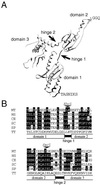Omnipotent decoding potential resides in eukaryotic translation termination factor eRF1 of variant-code organisms and is modulated by the interactions of amino acid sequences within domain 1
- PMID: 12084909
- PMCID: PMC124286
- DOI: 10.1073/pnas.142690099
Omnipotent decoding potential resides in eukaryotic translation termination factor eRF1 of variant-code organisms and is modulated by the interactions of amino acid sequences within domain 1
Abstract
In eukaryotes, a single translational release factor, eRF1, deciphers three stop codons, although its decoding mechanism remains puzzling. In the ciliate Tetrahymena thermophila, UAA and UAG codons are reassigned to Gln codons. A yeast eRF1-domain swap containing Tetrahymena domain 1 responded only to UGA in vitro and failed to complement a defect in yeast eRF1 in vivo at 37 degrees C. This finding demonstrates that decoding specificity of eRF1 from variant code organisms resides at domain 1. However, the wild-type eRF1 hybrid fully restored the growth of eRF1-deficient yeast at 30 degrees C. Tetrahymena eRF1 contains a variant sequence, KATNIKD, at the tip of domain 1. The TASNIKD variant of hybrid eRF1 rendered the eRF1-nullified yeast viable, although in an in vitro assay, the same hybrid eRF1 responded only to UGA. Nevertheless, the yeast eRF1 bearing the KATNIKD motif instead of the TASNIKS heptapeptide present in higher eukaryotes remains omnipotent in vivo. Collectively, these data suggest that variant genetic code organisms like Tetrahymena have an intrinsic potential to decode three stop codons in vivo, and that interaction within domain 1 between the KAT tripeptide and other sequences modulates the decoding specificity of Tetrahymena eRF1.
Figures



Similar articles
-
[How translation termination factor eRF1 Euplotes does not recognise UGA stop codon].Mol Biol (Mosk). 2007 Nov-Dec;41(6):1014-22. Mol Biol (Mosk). 2007. PMID: 18318120 Russian.
-
Different modes of stop codon restriction by the Stylonychia and Paramecium eRF1 translation termination factors.Proc Natl Acad Sci U S A. 2007 Jun 26;104(26):10824-9. doi: 10.1073/pnas.0703887104. Epub 2007 Jun 15. Proc Natl Acad Sci U S A. 2007. PMID: 17573528 Free PMC article.
-
Class I release factors in ciliates with variant genetic codes.Nucleic Acids Res. 2001 Feb 15;29(4):921-7. doi: 10.1093/nar/29.4.921. Nucleic Acids Res. 2001. PMID: 11160924 Free PMC article.
-
[Molecular mechanism of stop codon recognition by eRF1: a wobble hypothesis for peptide anticodons].Tanpakushitsu Kakusan Koso. 2001 Dec;46(15):2163-70. Tanpakushitsu Kakusan Koso. 2001. PMID: 11762076 Review. Japanese. No abstract available.
-
Eukaryotic translation termination factor 1 associates with protein phosphatase 2A and targets it to ribosomes.Biochemistry (Mosc). 1999 Dec;64(12):1373-81. Biochemistry (Mosc). 1999. PMID: 10648961 Review.
Cited by
-
Common and specific amino acid residues in the prokaryotic polypeptide release factors RF1 and RF2: possible functional implications.Nucleic Acids Res. 2005 Sep 14;33(16):5226-34. doi: 10.1093/nar/gki841. Print 2005. Nucleic Acids Res. 2005. PMID: 16162810 Free PMC article.
-
Overcoming stalled translation in human mitochondria.Front Microbiol. 2014 Jul 18;5:374. doi: 10.3389/fmicb.2014.00374. eCollection 2014. Front Microbiol. 2014. PMID: 25101074 Free PMC article.
-
Stop codon selection in eukaryotic translation termination: comparison of the discriminating potential between human and ciliate eRF1s.EMBO J. 2003 Apr 1;22(7):1644-53. doi: 10.1093/emboj/cdg146. EMBO J. 2003. PMID: 12660170 Free PMC article.
-
Termination of translation in eukaryotes is mediated by the quaternary eRF1*eRF3*GTP*Mg2+ complex. The biological roles of eRF3 and prokaryotic RF3 are profoundly distinct.Nucleic Acids Res. 2006;34(14):3947-54. doi: 10.1093/nar/gkl549. Epub 2006 Aug 12. Nucleic Acids Res. 2006. PMID: 16914449 Free PMC article.
-
Atomic mutagenesis of stop codon nucleotides reveals the chemical prerequisites for release factor-mediated peptide release.Proc Natl Acad Sci U S A. 2018 Jan 16;115(3):E382-E389. doi: 10.1073/pnas.1714554115. Epub 2018 Jan 3. Proc Natl Acad Sci U S A. 2018. PMID: 29298914 Free PMC article.
References
-
- Nakamura Y, Ito K, Ehrenberg M. Cell. 2000;101:349–352. - PubMed
-
- Kisselev L L, Buckingham R H. Trends Biochem Sci. 2000;25:561–567. - PubMed
-
- Nakamura Y, Ito K, Isaksson L A. Cell. 1996;87:147–150. - PubMed
-
- Tate W P, Poole E S, Mannering S A. Prog Nucleic Acids Res. 1996;52:293–335. - PubMed
-
- Ito K, Uno M, Nakamura Y. Nature (London) 2000;403:680–684. - PubMed
Publication types
MeSH terms
Substances
LinkOut - more resources
Full Text Sources
Molecular Biology Databases

